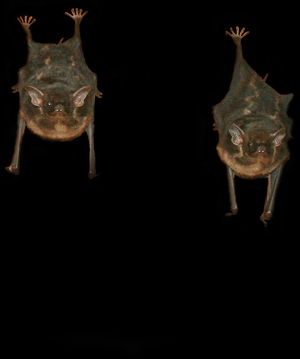|
Discover the
hidden treasures of Drake Bay, Costa Rica with Tracie "The Bug Lady"

Home

Tour
Basics

Meet the Bug
Lady

Tales from the
Edge

Media

Reservations

Links



Facts about Drake Bay, Costa Rica

Travel To Drake Bay

Drake Bay Area Map

Hotel Information

Tips for Travelers

Tours

Recommended
Reading

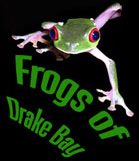



|
|
|
White-lined
bats
Saccopteryx sp. |
Greater White-lined Bats -
Saccopteryx bilineata
|
|
White-lined bats are some of the most conspicuous bats you are
likely to see while visiting the Osa Peninsula. These clever little
bats are fond of using the overhangs of houses, or ecolodges, as
their roosts and have learned to coexists with humans even in very
altered environments.
There are two species of
White-lined Bats in Costa Rica and they are both very similar: the
Greater White-Lined Bat (Saccopteryx bilineata) and the
Lesser White-lined Bat (Saccopteryx leptura). The
Brazilian-long Nosed Bat is the
only other Costa Rican bat with two white lines on its back, but it
is easily distinguished by its flecked, grayish fur and very long
nose.
White-lined Bats are quite small, with adults normally measuring
about 5 centimeters. They are also called Sac-winged Bats because
they have a sac shaped scent gland on their wings, near the forearm.

Lesser
White-lined Bat - Saccopteryx
leptura
Lesser White-lined Bats live in small colonies. Males and
females tend to form long lasting, monogamous pairs. Male bats fill
their sacs with saliva, urine and other secretions. These liquids
ferment and provide the males with a perfume which is unique to each
male. Scientists believe this scent helps female bats choose their
mate.
Greater White-lined Bats normally live in small harems made up of
one male and up to eight females, but colonies of up to fifty bats
have been documented. These large colonies are usually made up of
several coexisting harems. Females will frequently switch to other
harems while males normally remain tied to their territories.
|
|
White-lined Bats are strict insectivores. They begin
foraging while it is still light out and hunt through the night.
While foraging they fly at an average speed of 5.75 meters per
second and eat mostly small beetles and flies. Males normally defend
a foraging territory and each female in the harem has her own
foraging territory within that space.
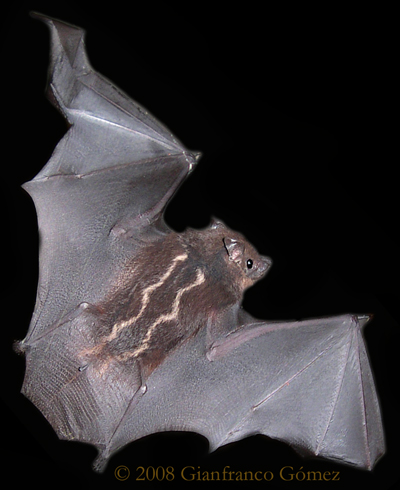
During their breeding season, harem males serenade each female as
they return from foraging. They
will indulge in long, complicated songs which are audible to humans.
As they sing, they will periodically hover in front of the females
and perfume them with their scent.
The perfume, which is also easily detected by humans, is released
from the scent sacs on their wings. This ritual may take place
several times throughout the day. Rival males will also partake in
long "scent flights" with one another, specially when their
territory shares a common border.
Despite all of the singing, displaying, and perfuming, copulation
for the Greater White-lined Bat only takes place during a short
period late in the rainy season. Females give birth to their pups in
May, in sync with the return of the rains. This pattern is different
in the Lesser White-lined Bat, and females may produce two litters.
In this case they will give birth in May and in October or November.
|
|
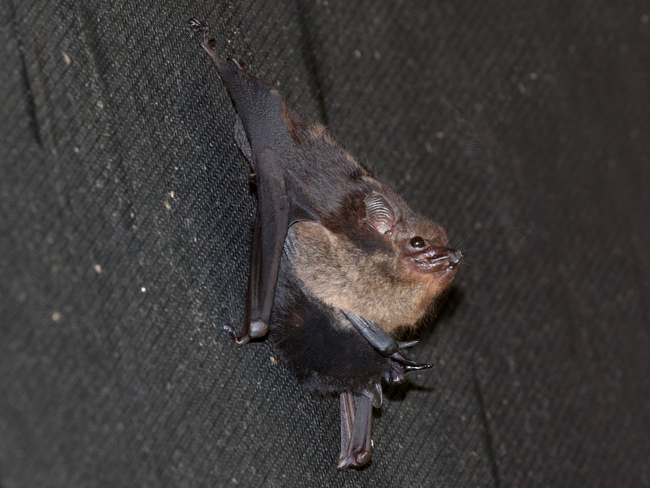
Female Greater White-lined Bat with her pup - Saccopteryx
bilineata
The
newborn bats suckle for several months, although they can
usually fly on their own when they are two weeks old. Females provide all the parental care to the young bats. Each night, when
females go out and forage, they take their pups away from the
daytime roost to a secret hiding place for them to pass the night
safely. Each pup has its own hiding spot. In the morning they
retrieve the pups and return with them to their daytime roost.
In August
and September, when they are three to four months old, the new
generation of White-lined Bats will leave the harem. Studies have
shown that females consistently leave the area, while about half of
the males will attempt to establish their own harems nearby. |
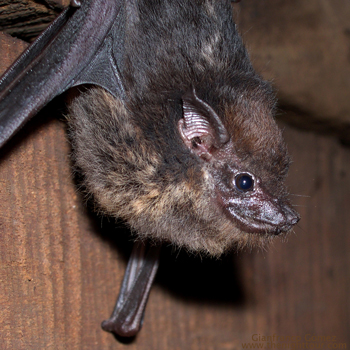
Greater White-lined Bat - Saccopteryx
bilineata
|
References:
Beletsky, L.
2005 Travellers' Wildlife Guides Costa Rica
Interlink Publishing
Janzen, D. 1983 Costa Rican Natural History
University of Chicago Press
LaVal, R. & Rodriguez, B. 2002 Murcielagos de Costa Rica/Bats
Editorial INBio
Wainwright, M. 2002 The Natural History of Costa
Rican Mammals Zona Tropical
|

|
|
|
|
Mammal
Files











|



 Alien Earthlings
Alien Earthlings  The
Dark Side
The
Dark Side





